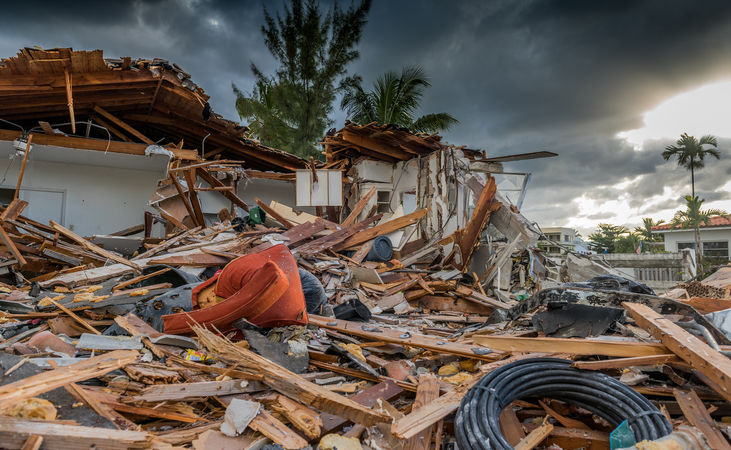From employment tax returns and payments to leave-sharing and donations to wage payment issues, businesses should consider the many areas of impact when a disaster strikes.
As Hurricane Dorian makes its way towards the coast of the United States, now is a good time to consider the various payroll and employment issues that arise when a disaster strikes a business.
Disaster Preparedness
The IRS recently issued a news release ahead of Hurricane Dorian providing guidance to employers about best practices in regards to recordkeeping for disaster preparedness. Employers are advised to store original documents such as tax returns or tax records in waterproof containers and place the container in a safe space. In addition, taxpayers should make copies of important documents and store the copies with a person outside of the disaster area or scan the documents to store the information electronically on a flash drive for example [IR 2019-147, 8/29/19].
After a Disaster
Reconstructing Records. The IRS offers some tips for reconstructing tax records after a disaster. Taxpayers may request a free return transcript on IRS.gov or by making a request by phone at (800) 908-9946. Taxpayers may request records to be mailed by submitting Form 4506 (Request for Copy of Tax Return) to request a copy of a tax return or by submitting Form 4506-T (Request for Transcripts of a Tax Return) to obtain tax return transcripts, tax account information, W-2 information, 1099 information, verification of nonfiling, and records of account [IRS FS 2017-11].
Change of Address. A taxpayer may need to relocate after a disaster. The IRS advises that taxpayers should complete returns based on the current address at the time of the filing. If a taxpayer moves after a return is filed, the taxpayer should contact the IRS at the IRS Disaster Assistance Hotline at (866) 562-5227 with the address change or submit Form 8822 (Change of Address) with the new address.
Taxability of Employer-Provided Disaster Assistance to Employees. Under Internal Revenue Code Sec. 139, qualified disaster relief payments made to an employee by an employer may be excluded from the employee’s taxable income. Qualified disaster relief payments include amounts to cover necessary personal, family, living or funeral expenses that were not covered by insurance. They also include expenses to repair or rehabilitate personal residences or repair or replace the contents to the extent that they were not covered by insurance. Again, these payments would not be included in the individual recipient’s gross income. “Qualified disasters” include: (1) a terror attack or military action; (2) a federally declared disaster; or (3) a disaster determined to warrant assistance by federal, state, or local authorities in connection with a qualified disaster to promote the general welfare. Like all charitable organizations, employer-sponsored private foundations should follow the guidance in IRS Publication 3833 (Disaster Relief: Providing Assistance Through Charitable Organizations).
Leave-Based Donation Programs. In the wake of 9/11, many employers set up leave-based donation programs to allow employees to forgo vacation, sick, or personal leave in exchange for employer contributions of cash payments to Internal Revenue Code Sec. 170(c) charitable organizations. In general, when services are rendered to an employer for a charitable organization, and an amount is paid to the organization by the employer, the amount paid is considered income to the employee who performed the services. Since then, this type of program is still used by employers as a response to disasters. The IRS will issue a notice in response to inform taxpayers regarding the taxability of such donations. For example, in 2018, the IRS approved employment tax relief for leave-based donation programs for victims of Hurricane Michael. These cash payments would not be included in Box 1, 3, or 4 of the employee’s W-2 and would not subject to withholding.
Leave-Sharing Programs. Leave donated by employees to an employer-sponsored leave bank under a major disaster leave-sharing plan is not taxable for the leave donor if certain requirements are met. A qualified plan is based on two factors: (1) the donated leave is used for medical emergencies, or (2) the donated leave is used to assist in recovery after a major disaster. The plan must treat payments made by the employer to the recipient employee as “wages” for employment tax purposes, unless the payments are excluded from taxation under a specific provision of the Internal Revenue Code. Also, the leave donor cannot claim an expense, charitable contribution, or loss deduction on account of the deposit of the leave or its use by a leave recipient.
More Resources. Finally, the IRS provides IRS Publication 2194 (Disaster Resource Guide for Individuals and Businesses) for those affected by a federally declared disaster and provides information regarding the assistance available to disaster victims including instructions on how to claim unreimbursed casualty losses on property that was damaged or destroyed.
Federal and State Tax Relief
Federal tax relief. Check the IRS webpage, Tax Relief in Disaster Situations, for the latest news on disaster tax relief. IRS tax relief information is also organized by state. Disaster relief for victims would provide an extended date to file tax returns (including employment tax returns) and the IRS will abate penalties up to a specified date. Generally, the postponement does not apply to the filing of W-2, 1098, 1099 or 5498 series, or to Forms 1042-S or 8027. The IRS will automatically identify taxpayers located in the covered disaster area and apply automatic filing and payment relief.
Disaster relief may be available to a taxpayer who is not located in the disaster area but whose tax preparer is located in the disaster area. Taxpayers may contact the Disaster Assistance Hotline at (866) 562-5227 for a postponement for filing or payment. The taxpayer should be prepared to provide the FEMA disaster number of the county the tax preparer is located.
While the IRS does not waive interest for balances due on prior-year liabilities that arise during the disaster relief period, the IRS will suspend installment agreement payments that become due during the period.
State tax relief. State employment tax relief may be available from the state taxing agency as well as other state taxing agencies for taxpayers who may be affected by a disaster in another state. For example, many state tax agencies provided withholding tax relief to Texas residents affected by Hurricane Harvey. Additionally, state unemployment agencies may provide relief by offering extensions for filing and payment and waiving penalties and interest under certain circumstances.
Employment considerations
Nonexempt employees. Under the Fair Labor Standards Act (FLSA), employers are only required to pay nonexempt employees for hours worked. Employers are not required to pay nonexempt employees for absences related to a disaster.
Exempt employees. In Department of Labor (DOL) Opinion Letter FLSA2005-46, the DOL states clearly that if an employer is open for business and an exempt employee does not report for work, the absence is considered an absence for personal reasons. Therefore, the employer may deduct one full-day’s absence from the salary of the exempt employee. However, an employer may not deduct less than a full-day’s absence. Exempt employees must be paid for the full week if the employer closes operations due to a disaster for part of that week.
Destroyed Time Records. Employers remain responsible for paying employees the minimum wage and overtime pay even in the event that time records have been destroyed.
Disaster Unemployment Assistance. Many employees will qualify for state unemployment benefits, however, for those employees that do not, they may be eligible for disaster unemployment assistance (DUA). DUA benefits may be available from the first day of the week following the date of the disaster and continue up to 26 weeks after that date. The maximum weekly benefit amount is based on the state’s maximum weekly benefit amount, but the minimum benefit is 50% of the average benefit in that state.
Worker Adjustment and Retraining Notification Act (WARN). The WARN Act (29 USC 2101) provides that covered employers must give 60 days written notice before plant closings or mass layoffs affecting 50 or more employees at a single worksite. In the event of a disaster, an employer may not be required to provide WARN notification if the closing or layoff is a direct result of a natural disaster under some circumstances. In general, employers are still required to provide notice to an employee’s last known address even if the employee’s home has been destroyed. However, if employee records have been destroyed, an employer may post notices at the worksite or provide notice in a newspaper.
Time off to respond to a disaster. State laws vary regarding whether an employer is required to provide time off (paid or unpaid) to an employee to respond to disaster relief efforts. State time off provisions may specify the terms of the time off. For example, the state law may specify the leave is related to the employee’s participation in the civil air patrol to respond to an emergency. Other laws may specify certain organizations, such as the American Red Cross or provide time off to emergency responders. States may also cap the amount of time off provided for such purposes.
Leave requests. Employers should be mindful that after a disaster, employees may request leave to handle personal affairs, injuries, or injuries of loved ones. Leave requests may come in the form of Family and Medical Leave Act (FMLA) leave or state required time off provisions.
Wage payment. While the majority of employees receive wages through direct deposit, it may be challenging to get those paper paychecks to employees. Employers should attempt to contact employees whenever possible to make arrangements to deliver paper paychecks. Employers should conduct due diligence by sending paychecks to the employee’s last known address if contact cannot be established.
Disaster Relief Employers and Employees
Many states exempt out-of-state employers who respond to an emergency in their state. These out-of-state businesses generally will not be considered to have established sufficient presence in the state to be subject to withholding tax as long as the employer is only in the state to perform disaster relief work. Also, the state may waive business registration requirements. Their out-of-state employees also will not be considered to have established sufficient presence in the state.
Additional Federal Resources
The Federal Emergency Management Agency (FEMA) website provides information regarding disaster preparation, current disaster situations, and information for individuals and businesses. In addition, access DisasterAssistance.gov to find resources for recent disasters and apply for assistance.
Flexible payroll solutions that are as unique as your firm
Increase profits, strengthen existing client relationships, and attract new clients with our trusted payroll solutions that accommodate in-house, outsourced, or hybrid models.
Or, shop for payroll information solutions designed to help you find trusted answers quickly on our store.









